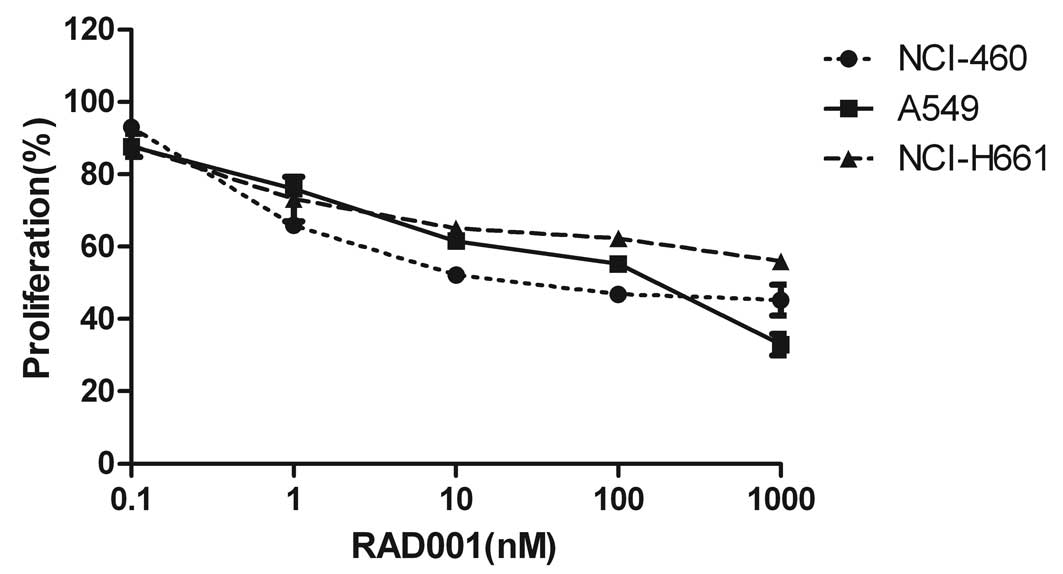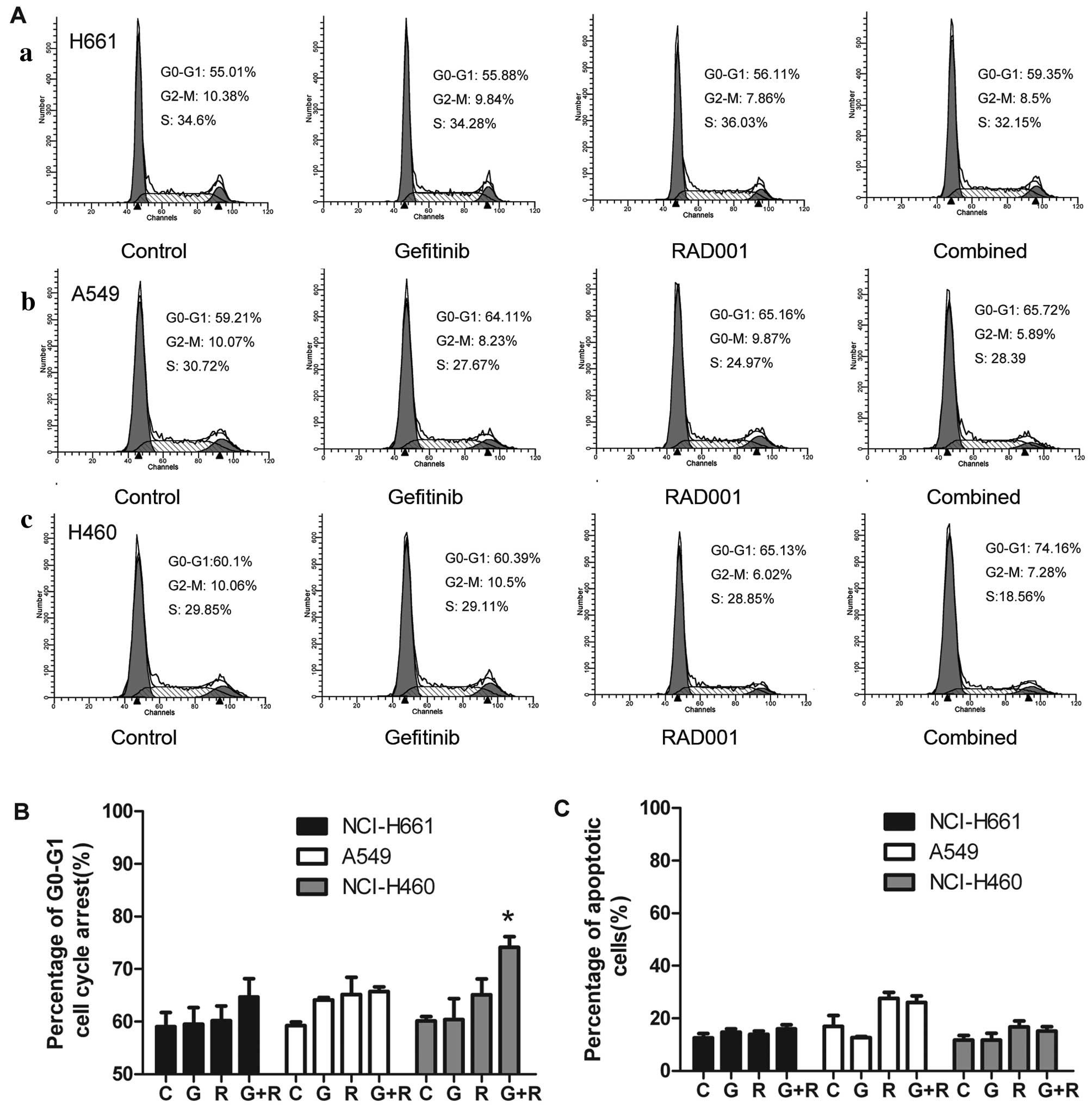|
1
|
Sharma SV, Bell DW, Settleman J and Haber
DA: Epidermal growth factor receptor mutations in lung cancer. Nat
Rev Cancer. 7:169–181. 2007. View
Article : Google Scholar : PubMed/NCBI
|
|
2
|
Wheeler DL, Dunn EF and Harari PM:
Understanding resistance to EGFR inhibitors - impact on future
treatment strategies. Nat Rev Clin Oncol. 7:493–507. 2010.
View Article : Google Scholar : PubMed/NCBI
|
|
3
|
Han SW, Kim TY, Hwang PG, et al:
Predictive and prognostic impact of epidermal growth factor
receptor mutation in non-small cell lung cancer patients treated
with gefitinib. J Clin Oncol. 23:2493–2501. 2005. View Article : Google Scholar : PubMed/NCBI
|
|
4
|
Chakravarti A, Loeffler JS and Dyson NJ:
Insulin-like growth factor receptor I mediates resistance to
anti-epidermal growth factor receptor therapy in primary human
glioblastoma cells through continued activation of phosphoinositide
3-kinase signaling. Cancer Res. 62:200–207. 2002.
|
|
5
|
Engelman JA, Janne PA and Mermel C: ErbB-3
mediates phosphoinositide 3-kinase activity in gefitinib-sensitive
non-small cell lung cancer cell lines. Proc Natl Acad Sci USA.
102:3788–3793. 2005. View Article : Google Scholar : PubMed/NCBI
|
|
6
|
Gorzalczany Y, Gilad Y, Amihai D, Hammel
I, Sagi-Eisenberg R and Merimsky O: Combining an EGFR directed
tyrosine kinase inhibitor with autophagy-inducing drugs: a
beneficial strategy to combat non-small cell lung cancer. Cancer
Lett. 310:207–215. 2011. View Article : Google Scholar : PubMed/NCBI
|
|
7
|
Morrow PK, Wulf GM, Ensor J, et al: Phase
I/II study of trastuzumab in combination with everolimus (RAD001)
in patients with HER2-overexpressing metastatic breast cancer who
progressed on trastuzumab-based therapy. J Clin Oncol.
29:3126–3132. 2011. View Article : Google Scholar : PubMed/NCBI
|
|
8
|
Bianco R, Garofalo S, Rosa R, Damiano V,
Gelardi T, Daniele G, Marciano R, Ciardiello F and Tortora G:
Inhibition of mTOR pathway by everolimus cooperates with EGFR
inhibitors in human tumours sensitive and resistant to anti-EGFR
drugs. Br J Cancer. 98:923–930. 2008. View Article : Google Scholar : PubMed/NCBI
|
|
9
|
Zoncu R, Efeyan A and Sabatini DM: mTOR:
from growth signal integration to cancer, diabetes and ageing. Nat
Rev Mol Cell Biol. 12:21–35. 2010. View
Article : Google Scholar : PubMed/NCBI
|
|
10
|
Yea SS and Fruman DA: Cell signaling. New
mTOR targets Grb attention. Science. 332:1270–1271. 2011.
View Article : Google Scholar : PubMed/NCBI
|
|
11
|
Atkins MB, Yasothan U and Kirkpatrick P:
Everolimus. Nat Rev Drug Discov. 8:535–536. 2009. View Article : Google Scholar : PubMed/NCBI
|
|
12
|
Mordant P, Loriot Y, Leteur C, et al:
Dependence on phosphoinositide 3-kinase and RAS-RAF pathways drive
the activity of RAF265, a novel RAF/VEGFR2 inhibitor, and RAD001
(Everolimus) in combination. Mol Cancer Ther. 9:358–368. 2010.
View Article : Google Scholar : PubMed/NCBI
|
|
13
|
Goldoni M and Johansson C: A mathematical
approach to study combined effects of toxicants in vitro:
evaluation of the Bliss independence criterion and the Loewe
additivity model. Toxicol In Vitro. 21:759–769. 2007. View Article : Google Scholar : PubMed/NCBI
|
|
14
|
Noro R, Gemma A, Kosaihira S, et al:
Gefitinib (Iressa) sensitive lung cancer cell lines show
phosphorylation of Akt without ligand stimulation. BMC Cancer.
6:2772006. View Article : Google Scholar : PubMed/NCBI
|
|
15
|
Di Nicolantonio F, Arena S, Tabernero J,
et al: Deregulation of the PI3K and KRAS signaling pathways in
human cancer cells determines their response to everolimus. J Clin
Invest. 120:2858–2866. 2010.PubMed/NCBI
|
|
16
|
Balko JM, Jones BR, Coakley VL and Black
EP: Combined MEK and EGFR inhibition demonstrates synergistic
activity in EGFR-dependent NSCLC. Cancer Biol Ther. 8:522–530.
2009. View Article : Google Scholar : PubMed/NCBI
|
|
17
|
Janmaat ML, Kruyt FA, Rodriguez JA and
Giaccone G: Response to epidermal growth factor receptor inhibitors
in non-small cell lung cancer cells: limited antiproliferative
effects and absence of apoptosis associated with persistent
activity of extracellular signal-regulated kinase or Akt kinase
pathways. Clin Cancer Res. 9:2316–2326. 2003.
|
|
18
|
Dobashi Y, Suzuki S, Kimura M, et al:
Paradigm of kinase-driven pathway downstream of epidermal growth
factor receptor/Akt in human lung carcinomas. Human Pathol.
42:214–226. 2011. View Article : Google Scholar : PubMed/NCBI
|
|
19
|
Yu Y, Yoon SO, Poulogiannis G, et al:
Phosphoproteomic analysis identifies Grb10 as an mTORC1 substrate
that negatively regulates insulin signaling. Science.
332:1322–1326. 2011. View Article : Google Scholar : PubMed/NCBI
|
|
20
|
Hsu PP, Kang SA, Rameseder J, et al: The
mTOR-regulated phosphoproteome reveals a mechanism of
mTORC1-mediated inhibition of growth factor signaling. Science.
332:1317–1322. 2011. View Article : Google Scholar : PubMed/NCBI
|
|
21
|
Shi Y, Yan H, Frost P, Gera J and
Lichtenstein A: Mammalian target of rapamycin inhibitors activate
the AKT kinase in multiple myeloma cells by up-regulating the
insulin-like growth factor receptor/insulin receptor
substrate-1/phosphatidylinositol 3-kinase cascade. Mol Cancer Ther.
4:1533–1540. 2005. View Article : Google Scholar
|
|
22
|
Goudar RK, Shi Q, Hjelmeland MD, et al:
Combination therapy of inhibitors of epidermal growth factor
receptor/vascular endothelial growth factor receptor 2 (AEE788) and
the mammalian target of rapamycin (RAD001) offers improved
glioblastoma tumor growth inhibition. Mol Cancer Ther. 4:101–112.
2005.
|
|
23
|
Gemmill RM, Zhou M, Costa L, Korch C,
Bukowski RM and Drabkin HA: Synergistic growth inhibition by Iressa
and rapamycin is modulated by VHL mutations in renal cell
carcinoma. Br J Cancer. 92:2266–2277. 2005. View Article : Google Scholar : PubMed/NCBI
|
|
24
|
Price KA, Azzoli CG, Krug LM, et al: Phase
II trial of gefitinib and everolimus in advanced non-small cell
lung cancer. J Thorac Oncol. 5:1623–1629. 2010. View Article : Google Scholar : PubMed/NCBI
|
|
25
|
La Monica S, Galetti M, Alfieri RR, et al:
Everolimus restores gefitinib sensitivity in resistant non-small
cell lung cancer cell lines. Biochem Pharmacol. 78:460–468.
2009.PubMed/NCBI
|
|
26
|
Vienna L, Fortunato B, Lorenza P, et al:
Phosphoinositide-3-kinase catalytic alpha and KRAS mutations are
important predictors of resistance to therapy with epidermal growth
factor receptor tyrosine kinase inhibitors in patients with
advanced non-small cell lung cancer. J Thorac Oncol. 6:707–715.
2011. View Article : Google Scholar
|
|
27
|
Elizabeth B, Alexandra E, Eric B, et al:
Rapamycin synergizes with the epidermal growth factor receptor
inhibitor erlotinib in non-small cell lung, pancreatic, colon, and
breast tumors. Mol Cancer Ther. 5:2627–2684. 2006.PubMed/NCBI
|
|
28
|
Magali R, Paul P, Amelie D, et al:
Mechanisms underlying resistance to cetuximab in the HNSCC cell
line: role of AKT inhibition in by passing this resistance. Int J
Oncol. 38:189–200. 2011.PubMed/NCBI
|
|
29
|
Tamburini J, Green AS and Bardet V:
Protein synthesis is resistant to rapamycin and constitutes a
promising therapeutic target in acute myeloid leukemia. Blood.
114:1618–1627. 2009. View Article : Google Scholar : PubMed/NCBI
|
|
30
|
Mohseni M and Park BH: PIK3CA and KRAS
mutations predict for response to everolimus therapy: now that's
RAD001. J Clin Invest. 120:2655–2658. 2010. View Article : Google Scholar : PubMed/NCBI
|



















